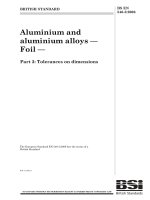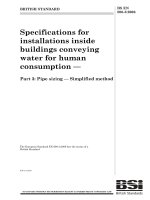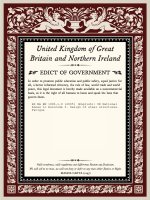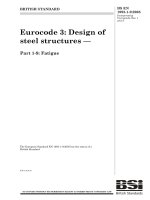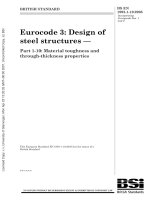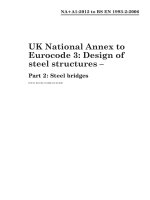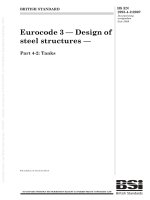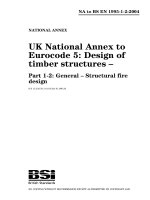Bsi bs en 01993 3 2 2006
Bạn đang xem bản rút gọn của tài liệu. Xem và tải ngay bản đầy đủ của tài liệu tại đây (1.26 MB, 33 trang )
Th
eEu
r
o
p
e
a
nUn
i
o
n
≠ EDI
CTOFGOVERNMENT±
I
no
r
d
e
rt
op
r
o
mo
t
ep
u
b
l
i
ce
d
u
c
a
t
i
o
na
n
dp
u
b
l
i
cs
a
f
e
t
y
,e
q
u
a
lj
u
s
t
i
c
ef
o
ra
l
l
,
ab
e
t
t
e
ri
n
f
o
r
me
dc
i
t
i
z
e
n
r
y
,t
h
er
u
l
eo
fl
a
w,wo
r
l
dt
r
a
d
ea
n
dwo
r
l
dp
e
a
c
e
,
t
h
i
sl
e
g
a
ld
o
c
u
me
n
ti
sh
e
r
e
b
yma
d
ea
v
a
i
l
a
b
l
eo
nan
o
n
c
o
mme
r
c
i
a
lb
a
s
i
s
,a
si
t
i
st
h
er
i
g
h
to
fa
l
lh
u
ma
n
st
ok
n
o
wa
n
ds
p
e
a
kt
h
el
a
wst
h
a
tg
o
v
e
r
nt
h
e
m.
EN 1993-3-2 (2006) (English): Eurocode 3: Design of steel
structures - Part 3-2: Towers, masts and chimneys – Chimneys
[Authority: The European Union Per Regulation 305/2011,
Directive 98/34/EC, Directive 2004/18/EC]
EUROPEAN STANDARD
EN 1993-3-2
NORME EUROPEENNE
EUROpAISCHE NORM
October 2006
Supersedes ENV 1993-3-2:1997
ICS 91.010.30; 91.060.40; 91.080.10
English Version
Eurocode 3 - Design of steel structures - Part 3-2: Towers,
masts and chimneys - Chimneys
Eurocode 3 - Calcul des structures en acier - Partie 3-2:
Tours, mats et cheminees - Cheminees
Eurocode 3 - Bemessung und Konstruktion von
Stahlbauten - Teil 3-2: Turme, Maste und Schornsteine Schornsteine
This European Standard was approved by CEN on 13 January 2006.
CEN members are bound to comply with the CEN/CEI\I ELEC Internal Regulations which stipulate the conditions for giving this European
Standard the status of a national standard without any alteration. Up-to-date lists and bibliographical references concerning such national
standards may be obtained on application to the Central Secretariat or to any CEN member.
This European Standard exists in three official versions (English, French, German). A version in any other language made by translation
under the responsibility of a CEN member into its own language and notified to the Central Secretariat has the same status as the official
versions.
CEN members are the national standards bodies of Austria, Belgium, Cyprus, Czech Republic, Denmark, Estonia, Finland, France,
Germany, Greece, Hungary, Iceland, Ireland, Italy, Latvia, Lithuania, Luxembourg, Malta, Netherlands, Norway, Poland, Portugal, Romania,
Slovakia, Slovenia, Spain, Sweden, Switzerland and United Kingdom.
EUROPEAN COMMITTEE FOR STANDARDIZATION
COMTT[~ EUROPEEN DE NORMALISATION
EUROpAISCHES KOMITEE FUR NORMUNG
Management Centre: rue de Stassart, 36
© 2006 CEN
All rights of exploitation in any form and by any means reserved
worldwide for CEI\I national Members.
B-1050 Brussels
Ref. No. EN 1993-3-2:2006: E
BS EN 1993-3-2:2006
EN
1993~3~2:
2006 (E)
Contents
1
General .......................................................................................................................................................5
1.1
1.2
1.3
1.4
1.5
1.6
2
Basis of design ............................................................................................................................................ 9
2.1
2.2
2.3
2.4
2.5
2.6
3
Modelling of the chimney for determining action effects ................................................................ 14
Calculation of internal stress resultants and stresses ........................................................................ 14
UltiInate Iill1it states ................................................................................................................................. 16
6. ]
6.2
6.3
6.4
6.5
7
Allowance for corrosion ................................................................................................................... 13
External corrosion allowance ........................................................................................................... 13
Internal corrosion allowance ............................................................................................................ 13
Structural analysis ................................................................................................................................... 14
5.1
5.2
6
General ............................................................................................................................................. 12
Structural steels ................................................................................................................................ 12
Connections ...................................................................................................................................... 12
Durability ................................................................................................................................................. 13
4.1
4.2
4.3
5
Requirelnents ...................................................................................................................................... 9
Principles of limit state design ......................................................................................................... 10
Actions and environmental influences ............................................................................................. 10
Ultimate limit state verifications ...................................................................................................... 12
Geonletrical data .............................................................................................................................. 12
Durability ......................................................................................................................................... ] 2
I\laterials .................................................................................................................................................. 12
3.]
3.2
3.3
4
Scope .................................................................................................................................................. 5
Norlllative references ......................................................................................................................... 6
ASSUJllptions ....................................................................................................................................... 6
Distinction between principles and application rules ......................................................................... 6
Tenns and definitions ......................................................................................................................... 6
Symbols used in Part 3.2 of Eurocode 3 ............................................................................................ 9
General ............................................................................................................................................. 16
Structural shells ................................................................................................................................ 17
Safety assessment of other structural elements of the chimney ....................................................... J 8
Joints and connections ...................................................................................................................... 18
Welded connections ......................................................................................................................... 19
Serviceabjlity Ihl1it states ........................................................................................................................ 19
7.1
7.2
Basis ................................................................................................................................................. 19
Deflections ....................................................................................................................................... 19
8
Design assisted by testing ........................................................................................................................ 20
9
Fatigue ...................................................................................................................................................... 20
9. I
9.2
9.3
9.4
9.5
General ............................................................................................................................................. 20
Fatigue loading ................................................................................................................................. 21
High cycle fatigue resistances .......................................................................................................... 21
Safety aSSeSSlllent ............................................................................................................................. 21
Partial factors for fatigue .................................................................................................................. 22
Annex A [nonnative] - Reliability differentiation and partial factors for actions ................................... 23
Reliability differentiation for steel chimneys ................................................................................... 23
A.2 Partial factors for actions .................................................................................................................. 23
A.I
2
BS EN 1993-3-2:2006
EN 1993·3-2: 2006 (E)
Annex B
B.I
B.2
B.3
BA
B.5
[informative] - Aerodynamic and damping measures ................................................................ 24
General ............................................................................................................................................. 24
Aerodynalnic Ineasures .................................................................................................................... 24
Dynalnic vibration absorber ............................................................................................................. 25
Cables with damping devices ........................................................................................................... 25
Direct dalnping ................................................................................................................................. 25
Annex C [informative] Fatigue resistances and quality requirenlents ................................................... 26
C.I General ............................................................................................................................................. 26
C.2 Enhancement of fatigue strength for special quality requirements .................................................. 26
Annex D [informative] - Design assisted by testing ....................................................................................29
D.I General ............................................................................................................................................. 29
D.2 Definition of the logarithmic damping decrement ........................................................................... 29
D.3 Procedure for measuring the logarithmic damping decrement.. ....................................................... 29
Annex E [informative] - Execution ............................................................................................................... 30
E.I General ............................................................................................................................................. 30
E.2 Execution tolerances ........................................................................................................................ 30
E.3 Quality of welds and fatigue ............................................................................................................ 30
3
BS EN 1993-3-2:2006
EN 1993-3-2: 2006 (E)
Foreword
This European Standard EN 1993-3-2, Eurocode 3: Design of steel structures: Part 3-2 Towers, masts and
chimneys ~ Chimneys, has been prepared by Technical Committee CEN/TC250 « Structural Eurocodes »,
the Secretariat of which is held by BSl. CEN/TC250 is responsible for all Structural Eurocodes.
This European Standard shall be given the status of a National Standard, either by publication of an identical
text or by endorsement, at the latest by April 2007 and conflicting National Standards shall be withdrawn
at latest by March 2010.
This Eurocode supersedes ENV 1993-3-2.
According to the CEN-CENELEC Internal Regulations, the National Standard Organizations of the
following countries are bound to implement this European Standard: Austria, Belgium, Cyprus, Czech
Republic, Denmark, Estonia, Finland, France, Germany, Greece, Hungary, Iceland, Ireland, Italy, Latvia,
Lithuania, Luxembourg, Malta, Netherlands, Norway, Poland, Portugal, Romania, Slovakia, Slovenia, Spain,
Sweden, Switzerland and United Kingdom.
National Annex for EN 1993-3-2
This standard gives alternative procedures, values and recommendations for classes with notes indicating
where national choices may have to be made. Therefore the National Standard implementing EN 1993-3-2
should have a National Annex containing a1l Nationally Determined Parameters to be used for the design of
steel structures to be constructed in the relevant country.
National choice is allowed in EN 1993-3-2 through paragraphs:
2.3.3.1(1)
2.3.3.5( 1)
2.6(1 )
4.2(1)
5.1 (l)
5.2.1(3)
6.1(I)P
6.2.1 (6)
6.4.1(1)
6.4.2( 1)
6.4.3(2)
1)
7.2(2)
9.1
9.1(4)
9.5(1 )
A.l(l)
A.2( 1) (2 places)
C.2(l)
4
BS EN 1993-3-2:2006
EN 1993-3-2: 2006 (E)
1
General
1.1
Scope
(1)
This Part 3.2 of EN 1993 applies to the structural design of veltical steel chimneys of circular or
conical section. It covers chimneys that are cantilevered, supp01ted at intermediate levels or guyed.
(2)
The provisions in this Part supplement those given in Part 1.1 of EN 1993.
(3)
This PaIt 3.2 is concerned only with the requirement for resistance (strength, stability and fatigue) of
steel chimneys.
NOTE: In this context (i.e. resistance) the term chimney refers to:
a) chimney structures
b) the steel cylindrical elements of towers
c) the steel cylindrical shafts of guyed masts
(4)
For provisions concerning aspects, such as chemical attack, thermo-dynamical performance or
thermal insulation see EN 13084-1. For the design of Ii ners see EN 13084-6.
(5)
Foundations in reinforced concrete for steel chimneys are covered in EN 1992 and EN 1997. See
also 4.7 and 5.4 of EN 13084-1.
(6)
Wind loads are specified in EN 1991-1-4.
NOTE: Procedures for the wind response of guyed chimneys are given in annex B of EN 1993-3-1.
(7)
This Part does not cover special provisions for seismic design, which are given in EN 1998-6. See
also 5.2.4.1 of EN 13084-1.
(8)
Provisions for the guys and their attachments are
(9)
For the execution of steel chimneys, reference should be made to EN 1090, Palt 2 and EN 13084-1.
in EN 1993-3-1 and EN 1993-1 11.
NOTE: Execution is covered to the extent that is necessary to indicate the quality of the construction
materials and products that should be used and the standard of workmanship on site needed to comply with the
assumptions of the design rules.
(10)
The following subjects are dealt with in EN 1993-3-2:
Section 1: General
Section 2: Basis of design
Section 3: MateIials
Section 4: Durability
Section 5: Structural analysis
Section 6: Ultimate limit states
Section 7: Serviceability limit states
Section 8: Design assisted by testing
Section 9: Fatigue
5
BS EN 1993-3-2:2006
EN 1993-3-2: 2006 (E)
1.2
Normative references
(1)
The following normative documents contain provisions which, through references in this text,
constitute provisions of this European standard. For dated references, subsequent amendments to or
revisions of any of these publications do not apply. However, parties to agreements based on this European
standard are encouraged to investigate the possibility of applying the most recent editions of the normative
documents indicated below. For undated references the latest edition of the normative document referred to
applies.
(~lsteel
EN 1090
Execution
EN 10025
Hot rolled prodllcts
EN 10088
Stain/e.)',)' steels
EN ]3084-]
Free standing industrial chimneys
EN ISO 5817
Vvelding - Fllsion-welded joints in steel, nickel, titanillm alld their alloys (beam welding
excluded) - Qllality levels/or impeJjections
structures and alllminillm structures
0/ non-alloy structllral steels.
Technica/
delivel~v
conditions
Part I : General Requirements
1.3
Assumptions
(I)
See 1.3 of EN ]993-1 1.
1.4
Distinction between principles and application rules
(I)
See ].4 of EN 1993-]-1.
1.5
Tern1s and definitions
(])
The terms and definitions that are defined in EN 1990 for common use in the Structural Eurocodes
apply to this Part 3.2 of EN 1993.
(2)
Supplementary to Paft I of EN 1993, for the purposes of this Part 3.2, the following definitions
apply. Definitions used for chimney structures are shown in Figure 1.1.
1.5.1
chimney
Vertical construction works or building components that conduct waste gases, or other flue gases, supply or
exhaust air to the atmosphere.
1.5.2
self-supported chimney
A chimney whose supporting shaft is not connected with any other construction above the base level.
1.5.3
guyed chinluey
A chimney whose supporting shaft is held in place by guys at one or more height levels.
1.5.4
single-wan chimney
A chimney whose structural shell also conducts the flue gases. It may be fitted by thermal insulation and/or
i nternall ini ng.
1.5.5
double-wall chinlney
A chimney consisting of an outer steel structural she1l and one inner liner which carries the flue gases.
6
BS EN 1993-3-2:2006
EN 1993-3-2: 2006 (E)
1.5.6
multi-flue chimney
A group of two or more chimneys structurally interconnected or a group of two or more liners within a
structural shell.
1.5.7
liner
The structural element (membrane) of the lining system, contained within the structural shell.
1.5.8
lining system
Total system, if any, which separates the flue gases from the structural shell. This comprises a liner and its
sUPPOJ1S, the space between the liner and structural shell and insulation, where existing.
1.5.9
structural shell
The main load-bearing steel structure of the chimney, excluding any flanges.
1.5.10
aerodynanlic device
A device fitted to the chimney to reduce vOJ1ex excitation without increasing the structural damping.
1.5.11
damping device
A device fitted to the chimney to reduce v0l1ex excited oscillations by increasing the structural damping.
1.5.12
spoiler
A device attached to the surface of a chimney with the objective of reducing cross wind response.
1.5.13
helical strakes, shrouds or slats
Devices fitted to the outer surface of the chimney to reduce cross wind response.
1.5.14
base plate
A horizontal plate fixed to the base of a chimney.
1.5.15
anchor bolt
A bolt for the connection of the chimney to the foundation.
1.5.16
stiffening rings
Horizontal members to prevent ovalling and to hold the chimney shell round during fabrication and transport.
Horizontal members to provide stiffeners at cut outs and openings or possibly at changes in slope of the
structural shell.
7
BS EN 1993-3-2:2006
EN 1993-3-2: 2006 (E)
1 Cravat
2 Tundish
2
20--<-- -+-----+
Multiflue chimney
Single wall chimney
Double wall chimney
Figure 1.1 Definitions used for Chimneys
8
3 Access door
4 Drain pipe
5 Base or
bearing plate
6 Cope hood
7 Cap plate
8 Cope angle
9 Lateral
supports
10 Mineral wool
insulation
11 Liners
12 Jointing
flange
13 Structural
shell
14 Inlet
15 Liner base
16 Base cone
17 Compression
ring
18 Base stool
19 Anchor bolts
20 Possible
stiffening ring
21 Top cone
22 Helical
aerodynamic
stabilizers
23 Intennediate
cone
24 Jointing
flange
25 Splitter plate
26 Damping
device
27 Liner
28 Access hooks
29 Base plate
BS EN 1993-3-2:2006
EN 1993-3-2: 2006 (E)
1.6
Symbols used in Part 3.2 of Eurocode 3
(l)
In addition to those given in EN 1993-1-1 the following main symbols are used.
c
corrosion allowance
number of cycles
diameter
bolt diameter
N
b
d
h
m
w
ref
crit
ext
F
height
slope
time
wind pressure
int
lat
top
R
Temp
reference
critical value
external
load
fatigue
internal
lateral (cross wi nd)
top
rupture
temperature
;l
1]
equivalence factor
factor to account for second order effects
(2)
Further symbols are defined where they first occur.
2
Basis of design
2.1
Requirements
2.1.1
Basic Requirements
(1)
See EN 1993-]-1.
f
(2)P
A chimney shall be designed so that provided it is properly constructed and maintained it is capable
of satisfying the fundamental requirements specified in EN 1990 and in EN 13084-1.
(3)
The structural design of guyed chimneys should be in accordance with the relevant clauses of
EN 1993-3-1 as well as this Part.
2.1.2
Reliability nlanagenlent
Different levels of reliability may be adopted for the ultimate limit states verifications for chimneys,
depending on the possible economic and social consequences of their collapse.
(1)
NOTE: For the definition of different levels of reliability see Annex A.
9
BS EN 1993-3-2:2006
EN 1993-3-2: 2006 (E)
2.2
Principles of limit state design
(I)
See 2.2 of EN 1993-1-1.
2.3
Actions and environmental influences
2.3.1
General
(I)P
The general requirements of section 4 of EN 1990 shall be satisfied.
(2)
The strength and stability of chimneys should be verified for the actions described in 2.3.2 and 2.3.3.
2.3.2
Pennanent actions
(1)
Tn calculating self-weight, the full thickness of steelwork should be considered, with no loss due to
corrOSlon.
(2)
The permanent actions should include the esti mated weight of all permanent structures and other
elements, including fittings, insulation, dust loads, clinging ash, coatings and other loads. The weight of the
chimney and its lining should be determined according to EN 1991-1-1 taking account of long-term effects
of fluids or moisture on the density of linings if relevant.
2.3.3
Variable actions
2.3.3.1 Imposed loads
(1)
Imposed loads should be applied on platforms and railings.
NOTE 1:
The National Annex may give information on imposed loads on platforms and railings. The
following characteristic values of imposed loads are recommended:
Imposed loads on platforms:
2,0 kN/m2
Horizontal loads on railings:
0,5 kN/m
(see also EN 13084-1)
... (2.1 a)
... (2.1 b)
NOTE 2: These loads may be assumed to act in the absence of other climatic loads.
2.3.3.2 Wind actions
(1)
Wind action should be taken from EN 1991-1-4.
(2)
Wind loads should be applied on the external surfaces of a chimney as a whole and on accessory
components, for example a ladder. Besides the drag forces due to the gusty wind acting in general in the
wind direction, forces due to vortex shedding that cause cross wind vibrations of a chimney should be
considered.
NOTE: For guyed chimneys see also Annex B to EN ] 993-3-1.
(3)
Other wind actions, for instance due to uneven wind pressure distribution (ovalling) or interference
effects, should be taken into account if the relevant criteria are exceeded, see 5.2.1.
(4)
Actions caused by interference galloping or classical galloping should be assessed according to
EN 1991-1-4.
(5)
If chimneys are predicted to be subject to excessive wind vibrations, measures may be taken to
reduce these in the design, or by installation of damping devices, see Annex B.
10
BS EN 1993-3-2:2006
EN 1993-3-2: 2006 (E)
2.3.3.3 Internal pressures
(1)
If events are possible that may lead to abnormal under-pressure or to over-pressure, these cases
should be treated as accidental loads.
NOTE: The under-pressure may he determined, for
from the gas flow velocilY, the gas density, the
total resistance to now and the ambient conditions. see EN 13084-1, Annex A.
2.3.3.4 Thennal actions
(1)
The thermal action may be composed of a temperature uniformly distributed over the structure and
differential temperature action caused by meteorological and operational effects including those arising from
an imperfect gas flow.
(2)
For meteorological thermal actions see EN 1991-1-5.
(3)
Temperatures from operational effects and due to imperfect gas flow, should also be taken into
account, see EN 13084-1 and EN 13084-6.
2.3.3.5 Ice loads
(1)
For chimneys that are likely to be subject to ice loading, the appropriate ice thicknesses, densities
and distributions should be determined.
NOTE 1: The National Annex may
further information on ice loading.
NOTE 2: See also 2.3.2 orEN 1993-3-1.
2.3.3.6 Seismic actions
(1)
Seismic actions should be determined from EN 1998-6. See also EN 13084-1.
2.3.3.7 Fire
(1)
The risk of a fire inside a chimney should be considered.
NOTE: Chimney fires may be caused by ignition of:
unburned fuel carried over the associated boiler or furnace;
unburned hydrocarbon carryover following a furnace tube rupture;
soot and sulphur deposits; and
any deposits, for example from textile industry, grease or condensates.
(2)
The load bearing structure should not fail due to fire action, and any other parts near the chi mney
should not be heated to their ignition temperature. If there is a risk of fire, appropriate fire proofing should
be provided. See EN 13084-6 and EN 13084-7.
2.3.3.8 Chemical actions
(1)
For chemical actions see EN 13084-1.
11
BS EN 1993-3-2:2006
EN 1993-3-2: 2006 (E)
2.4
Ultimate limit state verifications
(I)
For design values of actions and combination of actions see EN 1990.
(2)
In addition to ultimate limit state and to fatigue assessment limiting amplitudes in the serviceability
limit state (see Section 7) may be relevant for design.
NOTE: For partial factors for ultimate limit states see Annex A.
2.5
Geometrical data
(I)
The stiffnesses and strengths of the structural parts should be determined with nominal geometrical
data taking account of both corrosion allowances or temperature effects if relevant, see sections 3 and 5.
2.6
Durability
(I)
Durabil ity should be satisfied by compl yi ng with the fatigue assessment
section 9) and
appropriate choice of the calculated shell thickness
4) andlor by appropriate corrosion protection. See
also section 4 of EN 1993-1-1.
NOTE: The National Annex may give information on the design service life of the structure. A service life of
30 years is recommended.
3
Materials
3.1
General
(I)
See EN 1993-1-], EN ]993-1-3 and EN 1993-1-4.
3.2
Structural steels
3.2.1
Material properties
(1)
Due account should be taken of the variation of mechanical properties of the steels due to ambient
and operational temperatures, see 3.2.2( 1).
(2)
For temperatures exceeding 400°C the effects of temperature creep should be considered to avoid
creep rupture.
(3)
For toughness requirements of structural steels see EN 1993-1-10.
3.2.2
Mechanical properties for structural carbon steels
(I)
For the mechanical properties of structural carbon steels S
S 275, S 355, S 420, S 460 and for
weathering steel S 235, S 275, S 355 see EN 1993-1-1. For properties at higher temperatures see
EN 13084-7.
3.2.3
IVlechanical properties of stainless steels
(I)
For the mechanical properties related to stainless steels see EN 1993-1-4 valid for temperature up to
400°C. For propel1ies at higher temperatures see EN 10088 and EN 13084-7.
3.3
Connections
(I)
For connection material, welding consumables, etc., see EN 1993-1-8.
12
BS EN 1993-3-2:2006
EN 1993-3-2: 2006 (E)
4
Durability
4.1
Allowance for corrosion
(1)
When allowance for corrosion is made for exposed surfaces, the calculations for the resistance and
fatigue should be based on the corroded thickness of the steel, unless the uncorroded thickness produces
more unfavourable stress conditions.
(2)
Allowance for corrosion should be the sum of external (cext) and internal allowances (Cilll) as given
below. Where relevant these allowances should be applied in all or part of each 10 year period.
This total allowance should be added to the thickness needed to satisfy the requirements for strength
(3)
and stabil ity of the members.
4.2
External corrosion allowance
(I)
External corrosion allowance should be appropriate to the environmental conditions.
NOTE: The National Annex may give values for the external allowance
values in Table 4.1 are recommended.
eext.
For normal environment lhe
Table 4.1 External corrosion allowance (Cext )
Protection system
painted carbon steel (with no planned programme for repainting)
painted carbon steel (with a planned programme for repainting)
painted carbon steel protected by insulation and waterproof cladding
unprotected carbon steel
unprotected weathering steel (see (3))
unprotected stainless steel
unprotected inner surface of the structural shell and unprotected outer
surface of the liner in a double skin or multi-flue chimney (for carbon
or weathering steel)
Exposure time
Each additional
Fi rst 10 years
10 years period
1 mm
0
Omm
0
1 mm
0
1,5 mm
1 mm
0,3 mm
0,5 mm
0
0
0,2mm
0,1mm
The external corrosion allowances only apply to the top 517 of the chimney, where 17 is the external
(2)
diameter of the chimney. When a chimney is sited in an aggressive environment, caused by industrial
pollution, nearby chimneys or close proximity to the sea, consideration should be given to increasing the
allowances or taking protective measures.
(3)
The following measures should be taken:
a) all connections should be designed to eliminate or minimise moisture retention. For example orientation
of members, edge and pitch distance, etc., should be taken into consideration, or detai led protection of
these connections should be provided;
b) vegetation at the ground line should be maintained clear of the structure; and
c) direct embedment or foundation attachments should be coated to minimize the potential for corrosion due
to contact with soil and exposure to constant moisture.
(4)
If weathering steel is used the measures set out in (3) should be adopted.
4.3
Internal corrosion allowance
(1)
Values of internal corrosion allowance (Cinl) for steel are given in EN ]3084-7.
13
BS EN 1993-3-2:2006
EN 1993-3-2: 2006 (E)
5
Structural analysis
5.1
Modelling of the chimney for determining action effects
Generally for ultimate limit state verifications of the chimney, possible composite action between the
structural shel1 and the liner should be disregarded. Restraints of the ]iner that may adversely affect the
safety of the shell should however be taken into account.
(I)
NOTE: Damping effects from interaction of the structural shell and the liner may be taken inlo account. The
National Annex may
further information.
The strength and stability of the liner should then be assessed with due regard to the deformations
imposed from the structural shell.
(2)
(3)
Due regard should be given to the temperature effects on the stiffness and strength of the steels used
in the chimney structure.
In calculating the stiffness of the chimney the corroded thickness of the shell should be adopted
unless the uncorroded thickness produces more onerous stress conditions. Due account of both the extemal
and internal corrosion should be considered in accordance with 4.2 and 4.3.
(4)
5.2
Calculation of internal stress resultants and stresses
5.2.1
Analysis of the structural shell
(1)
For the calculation of stress resultants and stresses in the structural she]] see EN 1993-1-6.
In general, linear shell analysis (LA), either by analytical tools or by finite elements, may be used.
NOTE: Rules and formulae for LA analysis of cylindrical and conical shells are given in EN 1993-1-6.
(3)
For unstiffened vertical circular cylindrical shel1s the membrane stresses from external actions may
be determined from membrane theory, treating the cylinder as a global beam, where sheJ] bending effects can
be neglected, apart from the circumferential bending moments due to non-uniform wind pressure distribution
around circumference:
NOTE: The criteria for neglecting shell effects may be given in the National Annex. The recommended
criteria are as follows:
... (5.])
where
(J
rill
is the total height
is the medium radius of the shell (i.e. in the middle of the plate)
is the corroded plate thickness
The circumferential bending moments per unit length may be approximately determined I'rom:
... (5.2)
where
H'e
is the wind pressure, acting on the external surface of a structure, determined from 5.] of EN
1991
1-4
taking z. as the height of the chimney.
Circumferential bending moments due to wind pressure (for basic wind velocities up to 25m/sec
I -4) may be neglected in unstiffened cylindrical shells where:
J~II
/
t ::;;
160
EN 1991." (5.3)
For ring-stiffencd cylindrical shells and for assernblies of ring-sliffened cylindrical and conical shells the
membrane stresses may, independent of the
14
e/
rill -
and rn/t-ratios, be determined from membrane theory
BS EN 1993-3-2:2006
EN 1993-3-2: 2006 (E)
treating the structure as a global beam. Shell bending effects may be neglected, provided that the following
conditions are ful filled:
ring stiffeners provided to carry wind pressure should be designed for the circumferential bending
moments
stiffeners provided at the intersections between cylinders and cones should be designed for the
equilibrium forces resulting from deviating the meridional membrane forces.
The stress resultants and stresses resulting from the above calculations should he used for both the strength
verification, see 6.2.1, and the shell buckling verification, see 6.2.2.
5.2.2
Imperfections
(])
Horizontal imperfections of se1f-supporting cantilevered chimneys should be allowed for by
assuming a lateral deviation, tl in [m], from the vertical at the top of:
6=~~1+ SO
500
where h
... (5.4)
h
is the total height of the chimney in [m].
(2)
Local imperfections of the structural shell are included in the strength formulae for the buckling
resistance given in EN ] 993-1-6 and need not be allowed for in the global analysis.
NOTE: See also relevant geometrical tolerances in Annex E.
(3)
Member imperfections of other members of the chimney for members with axial compression should
be considered in accordance with 5.3 of EN ] 993-1 I.
5.2.3
Global analysis
(1)
When the structural shell is calculated as a beam, see 5.2.], it may be ca1culated using global first
order beam theory, when:
Nh
where Nb
Ncrit
0,10
... (5.5)
is the design value of the total ve11ical load, at the foot of the shell
is the elastic critical value for failure, at the foot of the shell (see EN 1993-1-6)
(2)
When the structural shell is calculated as beam, see 5.2.1, and global second order theory has to be
applied, the second order bending moments, M~ for the beam may be approximately determined from the
first order moment, M b , from:
... (5.6)
.. , (5.7)
with
where h
is the total height of the shell
El is the bending stiffness at the foot of the shell
15
BS EN 1993-3-2:2006
EN 1993-3-2: 2006 (E)
(3)
This simplified method may only be applied when:
77:::; 0,8; and
... (5.8a)
N
~ :::;0,10
... (5.8b)
Nh
where Ntop
is the design value of the total ve11icalload at the top of the shell.
6
Ultimate limit states
6.1
General
(I)P
The partial factor 1M shall be taken as follows:
resistance of structural elements or members related to the yield strength
when no global or local buckling occurs
f~,
IMO
resistance of structural elements or members related to the yield strength fy,
where global or local buckling is considered
resistance of structural elements or members related to the ultimate tensile
strengthfu
resistance of connections and joints
see EN 1993-1-8
NOTE: Partial factors for chimneys may be defined in the National Annex. The following numerical values
are recommended:
IMO = 1,00
(2)P
)MI
= 1,10
)M2
= 1,25
Chimneys shall be checked for the fol1owing ultimate limit states:
static equilibrium;
strength of its structural elements;
overall stability;
local buckling of its structural elements;
fatigue (including low cycle fatigue if relevant) of its structural elements; and
failure of connections.
16
BS EN 1993-3-2:2006
EN 1993-3-2: 2006 (E)
6.2
Structural shells
6.2.1
Strength verification
(1)
The strength of the structural shell and liner should be verified by checking it for the ultimate limit
state of plastic collapse or tensile rupture.
When the structural shell or liner is designed for external actions as a global beam, see 5.2.1, it
(2)
should be verified according to EN 1993-] -J or EN 1993-1
taking due account of the class of section.
(3)
In all other cases the structural shelI or liner should be verified according to the methods given in
EN ] 993-1-6.
Weakening of cross-section components by cut-outs and openings (e.g. manholes, flue openings,
(4)
etc.) should be compensated for by adequately sized reinforcement, taking into account local shell stability
and fatigue
as a result of which stiffeners may be required around the edges
Figure 6. J).
-----.----..J,i
,i'.--------------ll i'~---'---
l
v
1---+---.,
~\t ____ _
-l ---
J__ _
2----t---~
I Possible st(ff'ening rings
r'\/
/~.l
2 Lon g itltdilla I 51" (fie 11 e,.
3 Cut out
Figure 6.1 Stiffening round cut-outs and openings
(5)
When longitudinal stiffeners are used, care should be taken to ensure that any circumferential
bending stresses of the shell wa11s, occurring in the vicinity above and below the respective openings are
included if load distribution of the meridional (longitudinal) stresses is considered.
The longitudinal stiffeners should be chosen long enough so as to be capable of distributing stresses
(6)
into the main area of the shell.
NOTE: The National Annex may define limils for lhe orening. The following limits are recommended:
Local stress distribution may generally be deemed to be satisfied if the stiffeners
above and below lhe
opening at least 0,8 times the spacing of lhe stifrencrs or 0,8 times the height of the opening, whichever is the
greatest and the maximum angle of the opening should be 120°.
(7)
Additional ring stiffeners attached at the hole's edge, and at the end of the longitudinal stiffeners,
17
BS EN 1993-3-2:2006
EN 1993-3-2: 2006 (E)
may be used for the absorption of the circumferential bending stresses.
(8)
Ring stiffeners should be checked according to annex C of EN 1993-1-6.
6.2.2
Stability verification
(I)
The stability of the structural shell should be verified by checking it for the ultimate limit state of
local shell buckling, using the methods given in section 8 of EN 1993-] -6.
(2)
When the structural shell is calculated for external actions as a global beam, see 5.2.1, the stress
design concept in EN 1993-1-6 shou Id be applied.
When global second order beam theory needs to be applied, see
the shell buckling check
should be carried out with meridional compressive membrane stresses which include second order effects.
6.3
Safety assessment of other structural elements of the chimney
(1)
The strength and stability of bar type elements of the chimney should be verified as pal1 of the
structural shell, see 6.2.
The strength and stability of liners of double-skin chimneys or multi-flue chimneys should be
(2)
verified analogously to the structural shell, see 6.2.
If relevant, the shell buckling check of a liner may be handled as a serviceability check, see section
7.
(4)
If the load bearing system of the chimney is connected to other structural elements, the strength and
stability of such elements and their connections should be verified in accordance with 6.2 and 6.4.
6.4
Joints and connections
6.4.]
General
(I)
For joints and connections see EN 1993-1-8.
NOTE: The partial factors for joints and connections in chimneys may be given in the National Annex. The
numerical values
in Table 2.1 of EN 1993-1-8 are recommended.
6.4.2
Flange bolted connections
(1)
The stress in the bolts and in the
of the loading transmitted by the shell.
NOTE: The National Annex may
(2)
used.
should be calculated taking consideration of the eccentricity
further information on the design of 1langc boiled conneetions.
Flanges should be continuously welded to the structural shell. Intermittent welding should not be
PreJoaded high strength bolts should be used.
The maximum distance between centres of the bolts should be lad. When considering Jeakage
(4)
effects, reference should be made to EN 13084 : Part 6 as the spacing may need to be reduced further
(possibly to 5d) where d is the diameter of the bolt.
(5)
The minimum bolt diameter should be d = 12 mm.
If the bolts are 110t inspectabJe during the whole lifetime of the chimney, internal flanges should
(6)
normally be avoided.
18
BS EN 1993-3-2:2006
EN 1993-3-2: 2006 (E)
(7)
The flanges should be formed into a ring to accurately fit the structural shell. Any gap between the
flange and the structural shell should be such as to allow the welding specification to be met.
(8)
The possibility of stress concentrations in the shell near the boIts, the bendi ng of the flange and of
the shell and additional stresses due to possible deformations should be considered.
(9)
Due consideration should be given to temperature and variation of temperature of the flange joint in
the joint design.
6.4.3
Connection of chinlney to the foundation or supporting structure
The connection of the
shell to the concrete foundation or to the supporting structure should
resist the overturning moment, normal force and shear force developed at the shell base and transmitted to
the foundation.
(1)
(2)
When the connection is made using a base plate and anchor bolts, the load in the bolts should be
calculated taking into consideration the eccentricity of the loading transmitted by the shell.
NOTE 1: The National Annex may give further information on the design
NOTE 2: For
or the connections to roundations.
verification see section 9.
NOTE 3: It may be posslble, for example, that non-preloaded bolts meet the fatigue requirements if
oscillations are signi ficantly reduced by llsing aerodynamic or damping devices.
(3)
If other methods of connecting the steel shell to the foundations are used, for instance by extending
and embedding the shell directly into the concrete foundation, it should be shown that the design model is
structura11y reliable, and the particular constructional details associated with the adopted method, should be
taken into account.
6.5
Welded connections
(1)
For connections in steel chimneys made by welding see EN 1993-1-8, EN 1993-1-9 and
EN 13084-1.
7
Serviceability limit states
7.1
Basis
(1)
The following serviceability limit states should be considered for steel chimneys:
deformations or deflections in the along wind direction and/or in the cross-wind direction which
adversely affect the appearance or effective use of the structure;
vibrations, oscillations or sway which may cause alarm among bystanders;
deformations, deflections, vibrations, oscillations or sway which cause damage to non-structural
elements.
(2)
Where simplified compliance rules are given in the relevant clauses dealing with serviceability limit
states, detailed calculations using combinations of actions need not be undertaken.
NOTE: Partial factors are normally taken as 1,00 for all serviceability limit states.
7.2
Deflections
(1)
The maximum value of deflection (~l1aJ as determined from EN 1991- I -4 in the along-wind
direction at the top of a self-supporting chimney due to the characteristic value of along-wind loading should
19
BS EN 1993-3-2:2006
EN 1993-3-2: 2006 (E)
be limited.
NOTE: The National Annex may give the limiting value. The following value is recommended:
... (7.1)
= hl50
where h is the overall height of the chimney.
(2)
The maximum values for the vibration amplitudes at the top of a self-supporting chimney due to
vortex shedding should be limited.
NOTE 1: For determining the maximum values see Annex E of EN 1991-1-4.
NOTE 2: The National Annex Illay
limiting values for vibration amplitudes. Where the reliability classes
according to Annex A of this Part are used the limiting values according to Table 7.1 are recommended.
Table 7.1 Recommendations for maximum amplitudes of cross-wind vibration
Reliability class
Limits to cross-wind vibration amplitude
I
3
0,05
times the outer diameter
2
0,10
times the outer diameter
1
0,15
times the outer diameter
8
Design assisted by testing
(1)
The provisions for design assisted by testing given in EN 1990 should be followed.
(2)
Values of logarithmic decrement different from EN 1991-1-4 should be proved by test. For guidance
see annex D.
9
Fatigue
9.1
General
(I)
Consideration should be given to possible fatigue effects that arise from stress ranges induced by inline forces and by cross wind forces.
NOTE: As fatigue frolll cross wind vortex vibrations normally governs design, the fatigue verification related
to inline forces need normally not be undertaken.
(2)
For fatigue verification see EN 1993-1-9.
(3)
Where the geometrical stress method is used, such as at openings or by a particular shape of
connection, stress concentration factors may be used according to EN 1993-] -6.
NOTE: The National Annex may give further information on the modelling for stress analysis.
20
BS EN 1993-3-2:2006
EN 1993-3-2: 2006 (E)
(4)
For chimneys made of heat resistant alloy steels which are used for temperatures> 400°C the
addition of the temperature induced damage with the fatigue damage should be duly accounted for.
NOTE: The National Annex may give further information.
(5)
This Part does not cover corrosion fatigue.
9.2
Fatigue loading
9.2.1
Along-wind vibrations
(1)
In assessing fatigue loading due to along-wind vibrations, gust effects need to be taken into account.
NOTE:
POI'
assessing fatigue loading from along-wind vibrations see 9.2.1 of EN 1993-3-1.
9.2.2
Cross-wind vibrations
(1)
The fatigue loading for cross-wind vibrations may be determined from the maximum stress ranges.
NOTE: For determining the stress ranges and the number of cycles see 2.4 and 1.5.2.6
1991-1-4.
(2)
or annex
E of EN
No fatigue verification need be undertaken for chimneys which are lower than 3m in height.
(3)
If the critical wind speed of the chimney for vortex excitation is greater than 20 m/sec the correlation
]ength(s) below 16m above ground need not be taken into account, see EN 1991-1-4.
(4)
Higher modes should be considered where the critical wind speed for those modes is below the
limiting value (see EN 1991-1-4).
9.3
High cycle fatigue resistances
(1)
For tables of fatigue resistances for constructional details of welded shell structures of chimneys, see
EN 1993-1-9.
NOTE: Guidance on the use of EN 1993-1-9 and enhancement of fatigue rcsistances according to the quality
of welds see Anncx C.
(2)
If there is a corrosion allowance for the plate thickness instead of a corrosion protection system, the
details should be classified one detail category lower than that value given in the tables of the detail
categories. (See Figure 7.1 of EN 1993-1-9.)
9.4
Safety assessment
(I)
The safety assessment for fatigue should be pelformed according to 8(2) EN 1993-] -9, using:
... (9.1)
is the equivalence factor to transfer dO'E to Nc = 2 x 106 cycles
where A
dO'E
(2)
is the stress range associated with N cycles (see 9.2) al10wing for stress concentration factors
where appropriate
The equivalence factor A may be determined from:
I
J- ( -N-6 J-;;;
-
where m
2xl0
... (9.2)
is the slope of the S-N curve
21
BS EN 1993-3-2:2006
EN 1993-3-2: 2006 (E)
9.5
Partial factors for fatigue
(1)
The partial factors for fatigue should be taken as specified in 3(6) and (7) and 6.2(1) of EN 1993-1
NOTE: The National Annex may give the numerical values for IFf and 1i1f' For IFf the value IFf = 1,00 is
recommended. For /'\11 see Table 3.1 in EN 1993-1-9.
22
BS EN 1993-3-2:2006
EN 1993-3-2: 2006 (E)
Annex A [normative] - Reliability differentiation and partial factors for
actions
A.1
Reliability differentiation for steel chimneys
(1)
Reliability differentiation may be applied to steel chimneys by the application of reliability classes.
NOTE: The National Annex may
relevant reliability classes related to the consequences
failure. The classes in Table A.I are recommended.
or structural
Table A.1 Reliability differentiation for chimneys
Reliability Class
3
2
1
Chimneys erected m strategic locations, such as nuclear power plants or in densely
populated urban locations. Major chimneys in manned industrial sites where the
economic and social consequences of their failure would be very high.
Al1 normal chimneys at industrial sites or other locations that cannot be defined as Class
1 or Class 3.
Chimneys built in open countryside whose failure would not cause injury. Chimneys
less than 16m high in unmanned sites.
A.2
Partial factors for actions
(I)
Partial factors for actions may be dependant on the reliability class of the chimney.
NOTE 1: ]n the choice of partial j~tcrors for permanent actions Xi and for vmiable actions YQ the dominance of
wind actions for the
may be taken into (lccounl.
NOTE 2: The National Annex may give numerical values of Xi and YQ. Where the reliability classes
recommended in A.I are used the numerical values in Table A.2 for Xi and YQ are recommended.
Table A.2 Partial factors for permanent and variable actions
Reliability Class, see NOTE
Type of Effect
Permanent Actions
Variable Actions
to 2.1.2
1,2
I ,6
3
unfavourable
],4
1,1
2
1,2
1,0
1
favourable
All Classes
1,0
0,0
Accidental situations
1,0
1.0
NOTE 3: The National Annex may also give information on the use of dynamic response analysis for wind
action, see also Annex B of EN 1993-3-1.
23
